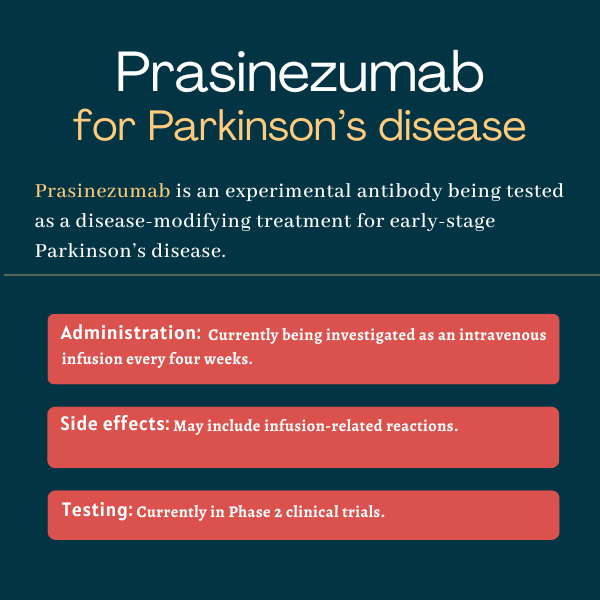Prasinezumab for Parkinson’s disease
Last updated Jan. 24, 2025, by Margarida Maia, PhD

What is prasinezumab for Parkinson’s disease?
Prasinezumab, formerly known as PRX002/RG7935, is an investigational antibody against alpha-synuclein, a protein that builds up into toxic clumps in Parkinson’s disease. It is being developed by Prothena, in collaboration with Roche, as an intravenous (into-the-vein) infusion to slow the progression of Parkinson’s in those with early-stage disease.
Therapy snapshot
| Treatment name: | Prasinezumab |
| Administration: | Being tested in early-stage Parkinson’s as an intravenous infusion |
| Clinical testing: | Currently in Phase 2 clinical trials |
How does prasinezumab work?
Parkinson’s disease is a progressive neurodegenerative disorder that results in the death of nerve cells in the brain that control movement. One potential cause of nerve cell death is the buildup of a protein called alpha-synuclein. In Parkinson’s, alpha-synuclein folds into an unusual shape that makes it prone to clumping into small structures known as fibrils. These fibrils can spread from one cell to the next and come together to form Lewy bodies, a hallmark of the disease.
Lewy bodies gradually drive the death of dopaminergic neurons, or the nerve cells in the brain that produce dopamine, which is a chemical involved in the control of voluntary movement. A shortage of dopamine can result in motor symptoms, which typically include slowness of movement, tremor, stiffness, and difficulty with balance and walking.
Prasinezumab is an antibody designed to bind to the C-terminus of aggregated forms of alpha-synuclein. The C-terminus is one of the two ends of a protein. By binding to alpha-synuclein, prasinezumab is expected to stop the protein from clumping and spreading across the brain, easing symptoms of Parkinson’s and slowing their progression over time.
In preclinical studies, an antibody designed to bind to the C-terminus of mouse alpha-synuclein was found to reduce the amount of protein that accumulated in the striatum, an area of the brain that receives input from dopaminergic neurons. The antibody prevented the death of dopaminergic neurons, reduced cell-to-cell spread of alpha-synuclein, and eased symptoms in the mouse model of Parkinson’s.
How is prasinezumab administered?
In Parkinson’s clinical trials, prasinezumab has been given as a monthly, hour-long intravenous infusion at a low dose of 1,500 mg or a higher dose of 3,500 mg for patients weighing less than 65 kg (about 143 pounds) or 4,500 mg for those weighing 65 kg or more.
Prasinezumab in clinical trials
Prasinezumab was first tested in a Phase 1 clinical trial (NCT02095171) with 40 healthy volunteers, ages 21 to 58, who were randomly assigned to receive a single intravenous infusion of either prasinezumab at ascending doses of 0.3, 1, 3, 10, or 30 mg/kg, or a placebo. Prasinezumab was found safe and well tolerated up to the highest tested dose, and resulted in a dose-dependent reduction of circulating free alpha-synuclein as early as one hour following the infusion.
In a Phase 1b clinical trial (NCT02157714), 80 adults with mild to moderate idiopathic (of unknown cause) Parkinson’s were randomly assigned to receive a total of three intravenous infusions, every four weeks, of either prasinezumab — at ascending doses of 0.3, 1, 3, 10, 30, or 60 mg/kg — or a placebo. As the case with healthy volunteers, prasinezumab was generally safe and well tolerated. However, two patients in the highest-dose group left the trial due to infusion-related reactions. A single infusion, at the highest tested dose, resulted in up to a 97% reduction of alpha-synuclein in the blood, with similar reductions observed after two additional infusions.
Based on these findings, two Phase 2 clinical trials, PASADENA (NCT03100149) and PADOVA (NCT04777331), were launched to gain proof of concept of prasinezumab as a disease-modifying treatment for Parkinson’s.
PASADENA trial
This two-part Phase 2 clinical trial included 316 adults with early-stage Parkinson’s, who were a mean age of 59.9 years. Patients were excluded if they were being treated for Parkinson’s with medications other than MAO-B inhibitors. The mean time since diagnosis was 10.1 months, or less than one year.
In the first part, patients were randomly assigned to receive one of two doses of prasinezumab (1,500 or 4,500 mg) or a placebo, both by infusion into the bloodstream every four weeks for 52 weeks, or one year. In the high-dose group, patients weighing less than 65 kg were given 3,500 mg instead of 4,500 mg.
After the first year, patients had the option to enter an open-label extension where all received prasinezumab for an additional 52 weeks. Those initially assigned to a placebo were randomly assigned to receive one of the two doses of prasinezumab, whereas those on prasinezumab continued on the same dose. Patients who completed the open-label extension were given the option to continue treatment with prasinezumab for an ongoing additional 260 weeks, or nearly five years.
The main goal was to watch for changes in motor and nonmotor symptoms after the first year of treatment using the Movement Disorders Society-Unified Parkinson’s Disease Rating Scale (MDS-UPDRS), in which higher scores indicate more severe symptoms. The main goal was not met, with patients showing similar increases in MDS-UPDRS scores after one year, regardless of whether they were on prasinezumab or the placebo.
However, further analysis of MDS-UPDRS part 3 scores revealed prasinezumab may slow the progression of motor symptoms in patients with more rapidly progressing Parkinson’s. For patients on MAO-B inhibitors versus no additional treatment, prasinezumab resulted in a greater reduction in MDS-UPDRS part 3 scores over the placebo (39% vs. 17.3%).
Three-year data also showed patients who had been initially assigned to prasinezumab were less likely to experience a clinically meaningful worsening of motor symptoms, defined as an increase of five points or more in MDS-UPDRS part 3 scores, compared with those who started prasinezumab with a one-year delay (84.4% vs. 92.4%). Similar observations were made for motor complications (58.8% vs. 21%).
PADOVA trial
This global Phase 2 clinical trial tested prasinezumab’s safety and efficacy versus a placebo in 586 adults with early-stage Parkinson’s, ages 50 to 85, who were on a stable dose of MAO-B inhibitors or levodopa.
Patients were randomly assigned to receive prasinezumab, at a dose of 1,500 mg, or a placebo every four weeks for at least 76 weeks, or roughly 1.5 years.
The main goal was to evaluate the time to reach a confirmed and clinically meaningful progression of Parkinson’s motor symptoms with prasinezumab versus the placebo. Side effects, including suicidal ideation, were also evaluated as well as the proportion of patients who experience infusion-related reactions.
While treatment with prasinezumab tended to slow the progression of motor symptoms, the trial failed to meet its main goal, meaning that the difference between prasinezumab and the placebo in the overall study population did not reach statistical significance.
Treatment with prasinezumab was associated with a non-statistically significant 16% lower odds of motor progression compared with a placebo.
Prasinezumab demonstrated a more pronounced effect in delaying motor progression among the 75% of study participants who were also receiving levodopa treatment. In this subgroup, prasinezumab was associated with a 21% reduction in the risk of motor symptom progression. Consistent positive trends favoring prasinezumab were also observed across several secondary and exploratory endpoints.
After the main study, participants could enter an open-label extension in which all are receiving prasinezumab for two years.

Common side effects of prasinezumab
Prasinezumab has been generally well tolerated in clinical trials with Parkinson’s patients. The most common side effects reported with prasinezumab include:
- infusion-related reactions, such as rash and nausea
- nose and throat inflammation
- back pain
- headache.
Parkinson’s News Today is strictly a news and information website about the disease. It does not provide medical advice, diagnosis, or treatment. This content is not intended to be a substitute for professional medical advice, diagnosis, or treatment. Always seek the advice of your physician or other qualified health provider with any questions you may have regarding a medical condition. Never disregard professional medical advice or delay in seeking it because of something you have read on this website.
Recent Posts
- Companies team on bringing Parkinson’s treatments to brain
- Dosing begins in clinical trial of Parkinson’s cell therapy RNDP-001
- MJFF awards grants to advance 5 new targets for Parkinson’s drugs
- Experimental vaccine shows early signs of benefit in Parkinson’s
- The unexpected gifts that Parkinson’s has prompted
Related articles






